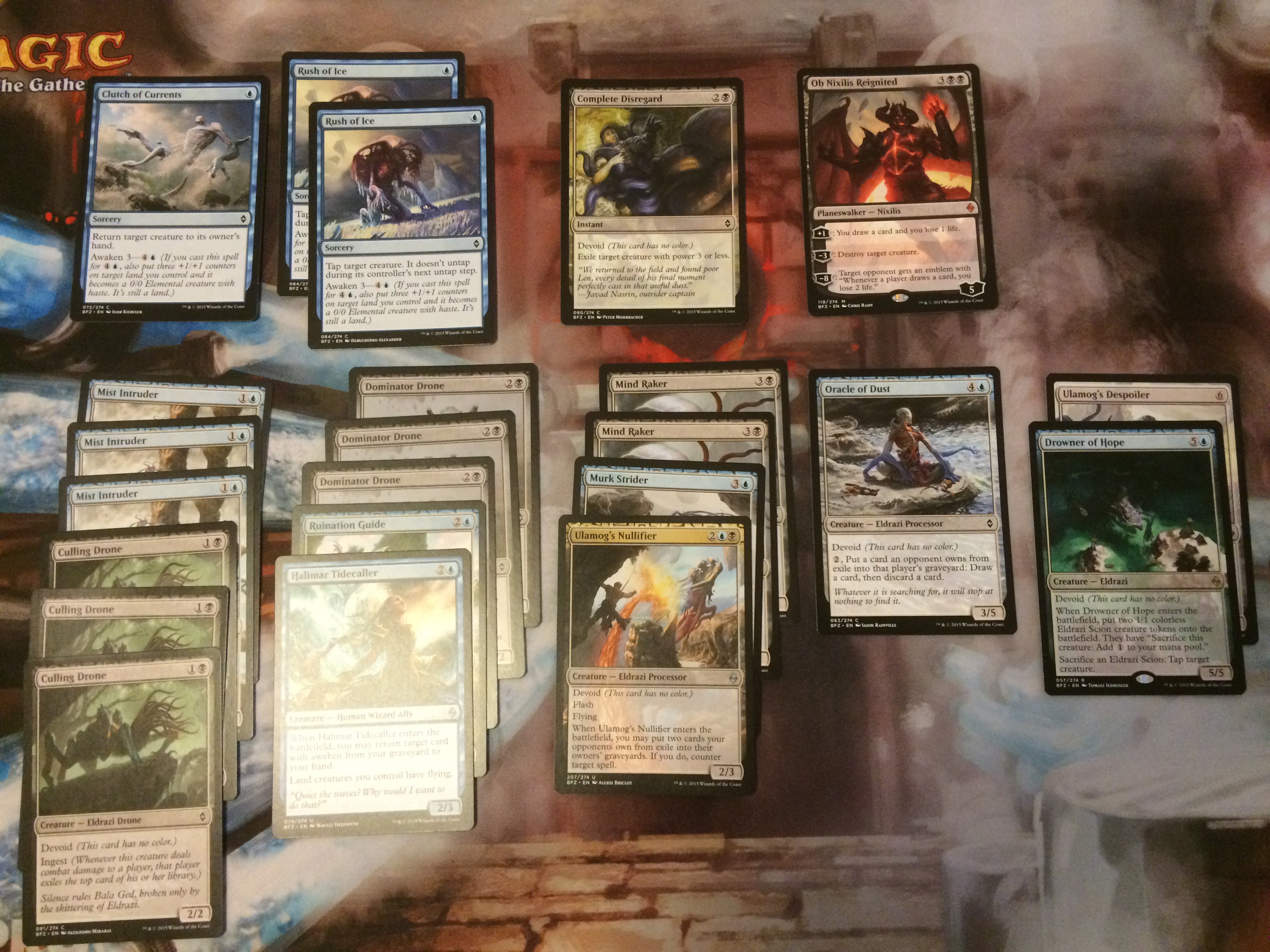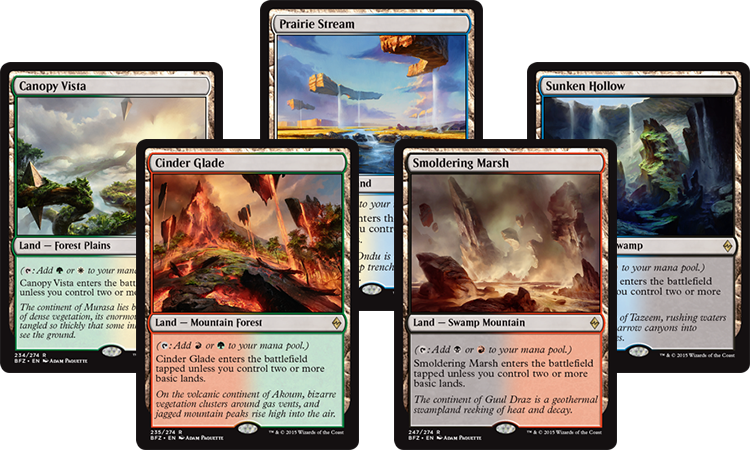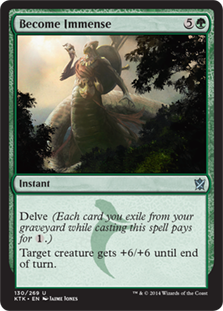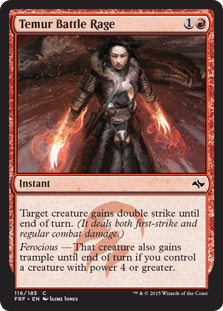Welcome back to Magic Gatherings!
Last week I spent some time writing about archetype guides in Battle for Zendikar limited—I hope you all had a chance to get to a booster draft this past week! I made it to Friday Night Magic draft at my local store, Pandemonium Books and Games, where they hosted a sellout crowd of 96(!) drafters.
@wizards_magic @pandybooks This is maybe 2/3s of the players waiting to draft Battle for Zendikar. 96 people! pic.twitter.com/KkEgHIFh9J
— Cute Fuzzy (@cutefuzzy_) October 2, 2015
I managed to put together this aggressive little blue-black ingest deck, #nofilter:
 This wound up pretty close to what I suggested in my article last week. There are lots of two-mana ingesters, as well as several processors at four, five, and six mana to use the exiled cards the early ingesters set up. Because I thought through the deck in advance, I knew to prioritize the evasive [mtg_card]Mist Intruder[/mtg_card], and also knew that this deck could have a little trouble punching through—hence the [mtg_card]Clutch of Currents[/mtg_card] and the [mtg_card]Rush of Ice[/mtg_card], which can temporarily get blockers out of the way. (I didn’t think to snag a [mtg_card]Swarm Surge[/mtg_card] during the draft, which would have been a very good inclusion.)
This wound up pretty close to what I suggested in my article last week. There are lots of two-mana ingesters, as well as several processors at four, five, and six mana to use the exiled cards the early ingesters set up. Because I thought through the deck in advance, I knew to prioritize the evasive [mtg_card]Mist Intruder[/mtg_card], and also knew that this deck could have a little trouble punching through—hence the [mtg_card]Clutch of Currents[/mtg_card] and the [mtg_card]Rush of Ice[/mtg_card], which can temporarily get blockers out of the way. (I didn’t think to snag a [mtg_card]Swarm Surge[/mtg_card] during the draft, which would have been a very good inclusion.)
All in all I think this is a great deck. It ably handled a four-color converge deck in round one, but took a loss to a very good red-green landfall deck in round two. Here, my relatively undersized creatures were at a disadvantage—my opponent’s [mtg_card]Snapping Gnarlid[/mtg_card]s, [mtg_card]Makindi Sliderunner[/mtg_card]s, and [mtg_card]Valakut Predator[/mtg_card]s were much bigger on his turn, which made blocking very tough for me (and also made his [mtg_card]Sure Strike[/mtg_card]s excellent).
As I mentioned at the end of last week’s article, it’s important to modify your archetype guides as you gain more experience with a draft format. After this past week, I know that aggressive decks like this, especially ones with black ground creatures like [mtg_card]Culling Drone[/mtg_card] and [mtg_card]Dominator Drone[/mtg_card], need to help their creatures get hits in—there are lots of high-toughness blockers, as well as two-power creatures, and both can be bad news.
This draft format looks very deep and very powerful. In my first few picks, I thought I might draft four- or five-color green, and only committed to blue-black when I opened [mtg_card]Ob Nixilis Reignited[/mtg_card] from my second pack (lucky, I know). Stay flexible, and if you have to switch plans midway through the draft, make sure you have in mind the pieces your deck will need. There are enough good cards that things can still turn out well.
That’s enough about limited for now, though. This week I’m diving into a topic I haven’t spent much time talking about: Standard!
Battle Standards
Standard is the most popular way to play organized tournament Magic. It’s a constructed format (as opposed to draft, which is a limited format), which means that you build your own deck and bring it with you to the tournament. In Standard, you’re allowed to build your deck with cards from the current set (i.e., Battle for Zendikar), plus last year’s sets. In Magic-ese, a “year” is defined when a new large set releases each fall, just like a school year. So, current Standard includes BFZ, plus Magic Origins, Dragons of Tarkir, Fate Reforged, and Khans of Tarkir.
[As an FYI, Magic will soon move to a new rotation system. That system is explained here. TL; DR: starting with Battle for Zendikar, each “block” will be two connected sets, a big one and a small one. Oath of the Gatewatch, coming January 2016, will be the second and final set of the Battle for Zendikar block. Standard will consist of the current block, plus the two previous blocks, so new cards will stay Standard-legal for about eighteen months.]
Standard is designed as a format with a smaller card pool that rotates relatively quickly, so new cards make a big splash when they come in. As such, new set releases are exciting times, as new cards form the basis for entirely new decks. That’s already clear, as the results from the first major tournament with Battle for Zendikar cards (the Star City Games Open in Indianapolis) has shown.
The most notable culprits are these guys, the “battle lands:”
 The battle lands are part of a rare breed, in that they have two basic land types—previously, we’ve only see that on the original ABUR dual lands and the Ravnica shock lands. These lands combine with “fetch” lands—seen recently in Khans of Tarkir—to make it very easy to play three, four, or even five colors.
The battle lands are part of a rare breed, in that they have two basic land types—previously, we’ve only see that on the original ABUR dual lands and the Ravnica shock lands. These lands combine with “fetch” lands—seen recently in Khans of Tarkir—to make it very easy to play three, four, or even five colors.
For example, when you sacrifice a [mtg_card]Windswept Heath[/mtg_card], it can not only find a [mtg_card]Canopy Vista[/mtg_card] (a Forest Plains), but it can also find the “Plains” half of [mtg_card]Prairie Stream[/mtg_card] or the “Forest” half of [mtg_card]Cinder Glade[/mtg_card]. That means your humble Heath can potentially give access to any color but black:
 With a little bit of setup work (playing or fetching basic lands in the first few turns), battle lands will almost always come into play untapped. And with an assortment of battle lands to find and fetch lands to find them with, you can have access to almost any color on demand. It’s an interaction top 8 competitor Gerry Thompson leveraged with this brand-new deck built around [mtg_card]Bring to Light[/mtg_card]:
With a little bit of setup work (playing or fetching basic lands in the first few turns), battle lands will almost always come into play untapped. And with an assortment of battle lands to find and fetch lands to find them with, you can have access to almost any color on demand. It’s an interaction top 8 competitor Gerry Thompson leveraged with this brand-new deck built around [mtg_card]Bring to Light[/mtg_card]:
[d title=”Gerry Thompson’s 5-Color Bring to Light” style=”embedded”]
Creatures
4 Jace, Vryn’s Prodigy
2 Nissa, Vastwood Seer
4 Siege Rhino
1 Clever Impersonator
1 Gilt-Leaf Winnower
1 Silumgar, the Drifting Death
Spells
2 Reave Soul
2 Disdainful Stroke
4 Abzan Charm
1 Sultai Charm
1 Ruinous Path
1 Utter End
1 Languish
2 Murderous Cut
1 Crux of Fate
1 Ugin’s Insight
4 Bring to Light
Lands
4 Flooded Strand
4 Windswept Heath
3 Bloodstained Mire
2 Windswept Heath
1 Wooded Foothills
1 Prairie Stream
1 Sunken Hollow
1 Smoldering Marsh
1 Cinder Glade
1 Canopy Vista
2 Forest
1 Plains
1 Island
1 Swamp
2 Lumbering Falls
1 Shambling Vent
Sideboard
2 Duress
2 Disdainful Stroke
2 Encase in Ice
2 Ob Nixilis Reignited
3 Radiant Flames
1 Radiant Purge
1 Silumgar, the Drifting Death
1 Silumgar’s Command
1 Anafenza, the Foremost
[/d]
You can also check the decklist on the Star City Games deck archive or on MtGGoldfish.com. The latter includes card prices and a nifty visualization option.
As you can see, Gerry’s manabase pushes this fetch-battle concept pretty hard: more than half of his lands are fetch lands, which allows him to consistently get the few basics and battle lands out of his deck and into play. That, in turn, makes it easy to cast spells of any color—or all colors, in the case of the deck’s namesake, [mtg_card]Bring to Light[/mtg_card]. In this deck, Bring to Light can find a timely removal spell, a sweeper like [mtg_card]Crux of Fate[/mtg_card], or just an endless parade of [mtg_card]Siege Rhino[/mtg_card]s.
The Siege Rhino Blues
Speaking of [mtg_card]Siege Rhino[/mtg_card], one other quirk of the fetch land-battle land interaction is that they’re not as helpful to the three-color Khans decks that have been so prevalent over the last year. Take a look at the diagram above and you can see why: the Khans of Tarkir fetch lands get every color except for one, and that one is always the last one you need to complete your “shard” manabase (two colors and their common enemy). As you can see, that Windswept Heath can’t find black, so an Abzan manabase (green-white-black) is out of luck.
The trick is that, while [mtg_card]Windswept Heath[/mtg_card] can’t find black mana, other fetches you’d naturally want to play anyway can. If you want to run [mtg_card]Canopy Vista[/mtg_card] to fix green and white mana in your Abzan deck, it makes sense to also play [mtg_card]Flooded Strand[/mtg_card]. ([mtg_card]Canopy Vista[/mtg_card] is part Plains, so [mtg_card]Flooded Strand[/mtg_card] can find it.) Once you’re in for that, you might as well play a [mtg_card]Sunken Hollow[/mtg_card]—your [mtg_card]Flooded Strand[/mtg_card] can find that, too, so now they can find any of your colors. Of course, now your “Abzan” deck can incidentally produce some blue mana.
The upshot of all this is that it’s actually easier to build a deck with four-color manabase than it is to build one with a three-color manabase. Several pro players put this principle into practice this weekend:
[d title=”Tom Ross’s Abzan Blue” style=”embedded”]
Creatures
4 Warden of the First Tree
3 Hangarback Walker
4 Den Protector
4 Anafenza, the Foremost
4 Siege Rhino
Spells
3 Dromoka’s Command
2 Valorous Stance
4 Abzan Charm
3 Murderous Cut
3 Gideon, Ally of Zendikar
Lands
4 Flooded Strand
4 Windswept Heath
4 Wooded Foothills
2 Polluted Delta
2 Canopy Vista
1 Prairie Stream
1 Smoldering Marsh
1 Sunken Hollow
3 Forest
1 Plains
1 Swamp
2 Llanowar Wastes
Sideboard
2 Arashin Cleric
1 Hidden Dragonslayer
2 Silkwrap
2 Disdainful Stroke
2 Dispel
1 Sorin, Solemn Visitor
3 Duress
2 Exert Influence
[/d]
Tom’s maindeck (SCG link, MtGGoldfish link) is close to the Abzan Aggro decks that have been popular at tournaments for months now. The difference is in the sideboard, which includes some very high-impact cards that he can cast off the blue mana from [mtg_card]Sunken Hollow[/mtg_card]: [mtg_card]Dispel[/mtg_card] against opposing removal, [mtg_card]Disdainful Stroke[/mtg_card] against opponents with expensive spells, and [mtg_card]Exert Influence[/mtg_card] to steal opposing creatures out of the, well, blue. Again, Tom wants to play [mtg_card]Sunken Hollow[/mtg_card] anyway, so that his Flooded Strands can find black mana—so this is a lot of power for a pretty painless splash.
The same concepts got put to use in a different color combination in this “Jeskai Black” deck, of which two copies made the top eight:
[d title=”Adam Varner’s Jeskai Black” style=”embedded”]
Creatures
2 Dragonmaster Outcast
4 Hangarback Walker
4 Jace, Vryn’s Prodigy
4 Mantis Rider
1 Butcher of the Horde
Spells
1 Dispel
1 Fiery Impulse
2 Wild Slash
3 Valorous Stance
4 Crackling Doom
1 Jeskai Charm
3 Gideon, Ally of Zendikar
2 Ojutai’s Command
3 Dig Through Time
Lands
4 Bloodstained Mire
4 Polluted Delta
3 Flooded Strand
2 Prairie Stream
2 Smoldering Marsh
1 Sunken Hollow
3 Plains
2 Mountain
1 Island
1 Swamp
2 Mystic Monastery
Sideboard
1 Dispel
3 Arashin Cleric
1 Disdainful Stroke
1 Negate
2 Surge of Righteousness
3 Radiant Flames
2 Touch of the Void
1 Ojutai’s Command
1 Tragic Arrogance
[/d]
This is the same concept as the first deck: you’re already running Smoldering Marsh so that Polluted Delta can find red mana, so including a [mtg_card]Butcher of the Horde[/mtg_card] and several copies of [mtg_card]Crackling Doom[/mtg_card] is easy. Clay Spicklemire chose different cards, but the same concept is in play with his take on Jeskai.
Sticking to Two Colors
Of course, just because you can play lots of colors, doesn’t mean you must. In fact, the deck that won the whole tournament was nearly mono-red, with just a light splash of green:
[d title=”Brian DeMars’s Atarka Red” style=”embedded”]
Creatures
4 Monastery Swiftspear
4 Zurgo Bellstriker
2 Lightning Berserker
4 Abbot of Keral Keep
1 Makindi Sliderunner
2 Chandra, Fire of Kaladesh
Spells
4 Wild Slash
4 Titan’s Strength
4 Dragon Fodder
4 Atarka’s Command
3 Temur Battle Rage
3 Become Immense
Lands
4 Bloodstained Mire
4 Wooded Foothills
2 Windswept Heath
2 Cinder Glade
8 Mountain
1 Forest
Sideboard
2 Fiery Impulse
4 Hangarback Walker
2 Roast
3 Arc Lightning
2 Goblin Heelcutter
2 Thunderbreak Regent
[/d]
Inasmuch as battle lands like [mtg_card]Cinder Glade[/mtg_card] can allow you to more easily play three, four, or five colors, they also make it very easy to splash a second color into an otherwise mono-colored deck, since they come into play untapped if you already have two or more basic lands in play. This deck is happy to have its first few lands be basic Mountains; after that point, [mtg_card]Cinder Glade[/mtg_card] will always be untapped, so green mana will always be online.
In addition to the classic aggressive red package of small, cheap creatures and a few burn spells, this deck also features a fabulous combo finish:


 Either of these two pump spells plus [mtg_card]Temur Battle Rage[/mtg_card] equals a lot of damage, basically out of nowhere. If you target [mtg_card]Monastery Swiftspear[/mtg_card], she’ll even get extra points of power, thanks to her prowess ability. The “pump and double-strike” plan helps shore up some of the power red lost when [mtg_card]Stoke the Flames[/mtg_card] and [mtg_card]Lightning Strike[/mtg_card] rotated out with Theros and Magic 2015. (Another theme of Standard is that decks often don’t have ideal pieces, so you need to make do. But as this deck shows, necessity is the mother of invention, in Magic as in life.)
Either of these two pump spells plus [mtg_card]Temur Battle Rage[/mtg_card] equals a lot of damage, basically out of nowhere. If you target [mtg_card]Monastery Swiftspear[/mtg_card], she’ll even get extra points of power, thanks to her prowess ability. The “pump and double-strike” plan helps shore up some of the power red lost when [mtg_card]Stoke the Flames[/mtg_card] and [mtg_card]Lightning Strike[/mtg_card] rotated out with Theros and Magic 2015. (Another theme of Standard is that decks often don’t have ideal pieces, so you need to make do. But as this deck shows, necessity is the mother of invention, in Magic as in life.)
This red deck edged out another two color deck—Michael Majors’s green-white Megamorph—in the finals:
[d title=”Michael Majors’s Green-White Megamorph” style=”embedded”]
Creatures
4 Warden of the First Tree
4 Hangarback Walker
4 Den Protector
2 Hidden Dragonslayer
4 Deathmist Raptor
3 Nissa, Vastwood Seer
3 Wingmate Roc
Spells
4 Dromoka’s Command
3 Valorous Stance
4 Gideon, Ally of Zendikar
Lands
4 Windswept Heath
4 Wooded Foothills
3 Flooded Strand
3 Canopy Vista
6 Forest
4 Plains
1 Blighted Steppe
Sideboard
3 Arashin Cleric
3 Evolutionary Leap
1 Mastery of the Unseen
1 Radiant Purge
2 Silkwrap
1 Valorous Stance
2 Tragic Arrogance
2 Whisperwood Elemental
[/d]
This deck has a straightforward gameplan—play good creatures and attack. It’s deeper than it might appear, though. First, a lot of its creatures have a great deal of natural resilience. [mtg_card]Deathmist Raptor[/mtg_card] can keep coming back, [mtg_card]Den Protector[/mtg_card] can regrow any card, and [mtg_card]Hangarback Walker[/mtg_card] and [mtg_card]Wingmate Roc[/mtg_card] can leave extra tokens around, even if the opponent removes the main threat.
More subtly, this deck has a lot of flexibility in how it plays out. [mtg_card]Den Protector[/mtg_card] and [mtg_card]Hidden Dragonslayer[/mtg_card] can be cast for two mana or three mana (as morphs). [mtg_card]Hangarback Walker[/mtg_card] can be a two-mana 1/1 or a four-mana 2/2. [mtg_card]Warden of the First Tree[/mtg_card] is a great attacker early and a good way to spend lots of mana in the late game. No matter how the tenor of the game develops, Majors options for how to play it.
Standardized Testing
There’s more to the world of Standard than the results from major tournaments, of course. We’re out of time for this week, but next week I’ll take a look at how to figure out what you want to play, and how to get the most out of it.
Around the Planes
Pro player Reid Duke’s excellent series “Level One” has wrapped up over at Wizards.com, and they did us the service of indexing the columns and collecting them onto one page: http://magic.wizards.com/en/articles/archive/level-one/level-one-full-course-2015-10-05
It’s a lot to read all at once, but if you’re interested in learning to play Magic better, or if you just enjoy seeing a great player break down the different systems that comprise a complex game, the series is well worth a look.
